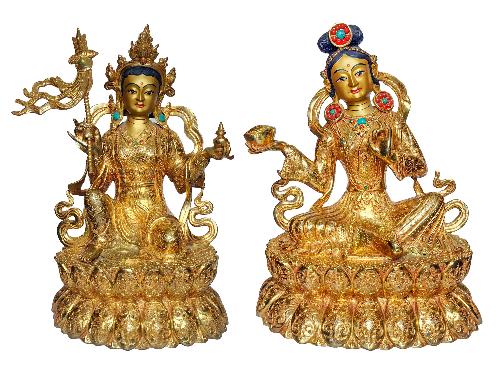Loading Content..

Mandarava, also known as Princess Mandarava, holds a significant place in Tibetan Buddhist iconography and lore as the wife of Padmasambhava, the legendary Indian tantric master who helped establish Buddhism in Tibet. Here's an overview of Mandarava's iconography:
Appearance: Mandarava is typically depicted as a youthful and beautiful figure, often adorned with elegant clothing and jewelry that symbolize her royal lineage. She is shown with a serene expression, embodying grace and wisdom.
Attributes: In her iconography, Mandarava may be portrayed holding various symbolic objects. One common attribute is the lotus (padma), which signifies purity and enlightenment. This connection to the lotus aligns her with the symbolism often associated with Padmasambhava (literally, "Lotus-Born").
Posture and Gestures: Mandarava is often depicted in a relaxed and meditative posture, sometimes seated on a lotus throne alongside Padmasambhava. Her hand gestures (mudras) can convey specific meanings such as teaching, meditation, or bestowing blessings.
Crown and Attire: As a princess, Mandarava's attire may include a crown or elaborate headdress, symbolizing her royal status. The attire is typically richly adorned but also reflects the simplicity and purity inherent to spiritual figures in Tibetan Buddhism.
Symbolism: Mandarava's iconography is rich in symbolism, representing her role as a consort and spiritual partner to Padmasambhava. Their union symbolizes the harmonization of wisdom and skillful means in tantric practice.
Lotus Symbolism: The lotus theme is central to Mandarava's iconography. It signifies purity and the potential for spiritual growth despite being rooted in muddy waters. This symbolism aligns with the transformative path of Buddhist practice.
Role in Practice: Mandarava is revered in Tibetan Buddhism as a realized yogini and a source of inspiration for practitioners, particularly in the context of tantric teachings. Her story with Padmasambhava exemplifies the transformative power of spiritual partnership and the path of enlightenment.
In Tibetan Buddhist art and practice, Mandarava's depiction alongside Padmasambhava highlights the importance of wisdom, compassion, and the transformative nature of spiritual partnership on the path to enlightenment.
Loading..
Please wait for the page to fully load for optimal functionality.
Loading Content..